
Shelby County is a county located in the U.S. state of Kentucky. As of the 2020 census, the population was 48,065. Its county seat is Shelbyville. The county was established in 1792 and named for Isaac Shelby, the first Governor of Kentucky. Shelby County is part of the Louisville/Jefferson County, KY–IN Metropolitan Statistical Area. Shelby County's motto is "Good Land, Good Living, Good People".

Anchorage is a home rule-class city in eastern Jefferson County, Kentucky, United States. The population was 2,500 as of the 2020 census, up from 2,348 at the 2010 census and an estimated 2,432 in 2018. It is a suburb of Louisville.

Jeffersontown is a home rule-class city in Jefferson County, Kentucky, United States. The population was 28,474 at the 2020 census.
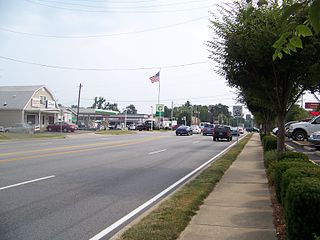
Lyndon is a home rule-class city in Jefferson County, Kentucky, United States. The population was 11,002 at the 2010 census, up from 9,369 at the 2000 census.

Middletown is an independent, home rule-class city in Jefferson County, Kentucky, United States, and a suburb of Louisville. The population was 7,218 at the 2010 census.

Shively is a home rule-class city in Jefferson County, Kentucky, United States, and a suburb of Louisville within the Louisville Metro government. As of the 2010 census, the city's population was 15,264, reflecting an increase of 107 (+0.7%) from 15,157 in 2000.

Crestwood is a home rule-class city in Oldham County, Kentucky, United States just outside Louisville's Northeast End. The population was 6,183 as of the 2020 census. CNN listed it as the 52nd best place to live in America in 2005.
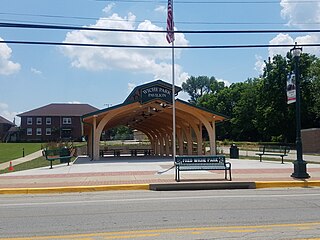
Simpsonville is a home rule-class city in Shelby County, Kentucky, in the United States. It is located 8 miles west of Shelbyville, Kentucky and 23 miles east of Louisville situated along U.S. 60. The population was 2,484 during the 2010 U.S. Census.

Prospect is a home rule-class city in Jefferson and Oldham counties in the U.S. state of Kentucky. The Jefferson County portion is a part of the Louisville Metro government. The population was 4,592 as of the 2020 census, down from 4,698 at the time of the 2010 census. It is one of the wealthiest communities in Kentucky.
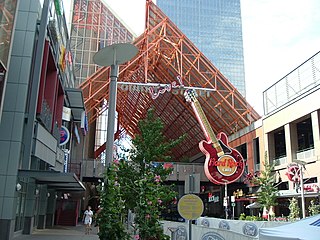
Fourth Street Live! is a 350,000-square-foot (33,000 m2) entertainment and retail complex located on 4th Street, between Liberty and Muhammad Ali Boulevard, in Downtown Louisville, Kentucky. It is owned and was developed by the Cordish Company; it was designed by Louisville architects, Bravura Corporation. Fourth Street Live! first opened to the public on June 1, 2004, and all stores were completed for the grand opening on October 30, 2004. City planners hoped that the district would attract further commercial business development while providing an attractive entertainment venue for the city's hotel and tourist business as well as the local population.
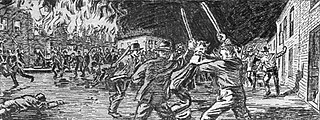
Bloody Monday was a series of riots on August 6, 1855, in Louisville, Kentucky, an election day, when Protestant mobs attacked Irish and German Catholic neighborhoods. These riots grew out of the bitter rivalry between the Democrats and the Nativist Know-Nothing Party. Multiple street fights raged, leaving twenty-two people dead, scores injured, and much property destroyed by fire. Five people were later indicted, but none were convicted, and the victims were not compensated.
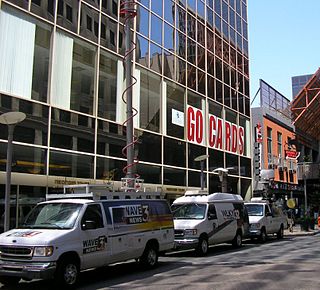
This is a list of media publications and sources in Louisville, Kentucky.

Fort Nelson, built in 1781 by troops under George Rogers Clark including Captain Richard Chenoweth, was the second on-shore fort on the Ohio River in the area of what is now downtown Louisville, Kentucky. Fort-on-Shore, the downriver and first on-shore fort, had proved to be insufficient barely three years after it was established. In response to continuing attacks from Native Americans and the threat of British attacks during the Revolutionary War, Fort Nelson was constructed between what is currently Main Street and the river, with its main gate near Seventh Street. It was named after Thomas Nelson Jr., then the governor of Virginia.

The 800 Tower, formerly The 800 Apartments, is a 29-story residential skyscraper in Louisville, Kentucky, located in the city's SoBro neighborhood, nestled between Old Louisville and downtown. At the time construction was complete in 1963, The 800 was the tallest building in Louisville, a record it maintained for nearly a decade.
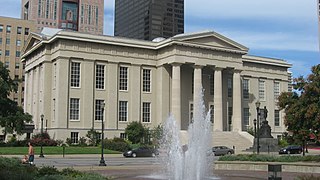
The Louisville Metro Hall is the center of Louisville, Kentucky's government. It currently houses the Mayor's Office and the Jefferson County Clerk's Office for marriage licensing, delinquent tax filings, and the deeds room. The building was placed on the National Register of Historic Places in 1972. Construction began in 1836, and both the City of Louisville and Jefferson County governments starting using it in 1842.
Jeptha Barnard Bright Jr, better known as Barney Bright, born in Shelby County, Kentucky and was a sculptor from Louisville, Kentucky, is best known for his work on the Louisville Clock.
The Louisville Raiders were a team in the United Football League from 1960 through 1962. Organized in March 1960, the team played their home games at Fairgrounds Stadium in Louisville, Kentucky. The Raiders went 4–6 in 1961 and 4–7–1 in 1962.
The Jeffersonian was a weekly newspaper published on Thursdays, in Jeffersontown, Jefferson County, Kentucky. The Jeffersonian was first published on June 13, 1907, and was last published in 1965.
The 1875 Kentucky Derby was the first running of the Kentucky Derby. The race took place on May 17, 1875. The first Kentucky Derby was a 1.5-mile race, and the traditional distance of 1.25 miles was not established until the 1896 Derby. Thirteen of the fifteen jockeys in the race, including winner Oliver Lewis, were African-American. Attendance was estimated at 10,000.



















